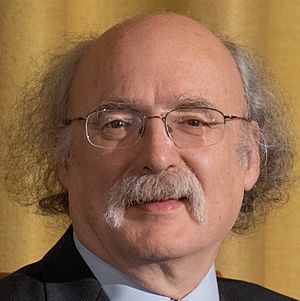Duncan Haldane facts for kids
Quick facts for kids
Duncan Haldane
FRS FInstP
|
|
|---|---|

Haldane in 2016
|
|
| Born |
Frederick Duncan Michael Haldane
14 September 1951 London, England
|
| Nationality | British, Slovenian |
| Citizenship | United Kingdom Slovenia |
| Education | St Paul's School, London |
| Alma mater | University of Cambridge (BA, PhD) |
| Known for | Haldane pseudopotentials in the fractional quantum Hall effect Quantum anomalous Hall effect |
| Awards |
|
| Scientific career | |
| Fields | Condensed matter theory |
| Institutions | |
| Thesis | An extension of the Anderson model as a model for mixed valence rare earth materials (1978) |
| Doctoral advisor | Philip Warren Anderson |
| Doctoral students | Ashvin Vishwanath |
Frederick Duncan Michael Haldane, born on September 14, 1951, is a British physicist. He is a top professor of physics at Princeton University. In 2016, he won the Nobel Prize in Physics along with David J. Thouless and J. Michael Kosterlitz. They were honored for their important discoveries about how matter can behave in strange and unexpected ways.
Contents
Early Life and Education
Duncan Haldane went to St Paul's School, London. He then studied at Christ's College, Cambridge. He earned his first degree there, and later his PhD in 1978. His research was guided by Philip Warren Anderson, another famous physicist.
Career and Scientific Discoveries
After finishing his studies, Professor Haldane worked in France. From 1977 to 1981, he was a physicist at the Institut Laue–Langevin.
Working in the United States
In August 1981, Professor Haldane moved to the United States. He became an assistant professor of physics at the University of Southern California. He stayed there until 1987. He was promoted to associate professor in 1981 and then full professor in 1986.
In July 1986, he joined the physics department at the University of California, San Diego. He worked there until February 1992. In 1990, he also started working at Princeton University. He has been a professor at Princeton ever since. In 1999, he became the Eugene Higgins Professor of Physics. In 2017, he was named the Sherman Fairchild University Professor of Physics.
Understanding Strange Materials
Professor Haldane is famous for his many important ideas in condensed matter physics. This field studies the properties of materials, especially solids and liquids. He helped us understand things like:
- Luttinger liquids: These are special types of one-dimensional (1D) materials where electrons behave in unusual ways.
- Spin chains: These are models that help explain how tiny magnets (spins) in a material interact in a line.
- Fractional quantum Hall effect: This is a very complex phenomenon seen in very cold, very strong magnetic fields. Electrons act as if they have only a fraction of their normal charge.
His work helps scientists design new materials with amazing properties.
New Ways to Describe Quantum Effects
Around 2011, Professor Haldane was working on a new way to describe the fractional quantum Hall effect (FQHE). He thought of it as a "quantum geometry." This new idea helps explain how these materials behave even better than older theories. It helps scientists understand the collective movement of particles in these strange states of matter.
Awards and Recognition
Professor Haldane has received many awards for his groundbreaking work.
- In 1992, he became a Fellow of the American Academy of Arts and Sciences.
- In 1993, he won the Oliver E. Buckley Prize from the American Physical Society. This is a very important award in condensed matter physics.
- He became a Fellow of the Royal Society (FRS) in 1996. This is a big honor in the UK.
- In 2012, he received the Dirac Medal.
- In 2017, he was elected a member of the U.S. National Academy of Sciences.
The Nobel Prize
In 2016, Professor Haldane shared the Nobel Prize in Physics. He shared it with David J. Thouless and J. Michael Kosterlitz. They won for their discoveries about "topological phase transitions" and "topological phases of matter." This sounds complicated, but it means they found new ways to understand how materials can change their properties in unexpected ways, based on their shape or "topology." Their work opened up new areas of research in physics.
Personal Life
Professor Haldane is a citizen of both Britain and Slovenia. He is also a permanent resident of the United States. He lives in Princeton, New Jersey, with his wife, Odile Belmont.
His mother, Ljudmila Renko, was Slovenian. She met his father, a British Army doctor, when he was stationed near the Yugoslavia/Austria border. They later moved to England, where Duncan was born. In 2019, Professor Haldane officially received Slovenian citizenship.
See also
 In Spanish: Duncan Haldane para niños
In Spanish: Duncan Haldane para niños
- Haldane–Shastry model
- Fractional quantum Hall effect
- Quantum spin Hall effect
- Photonic topological insulator
- Spin–charge separation

